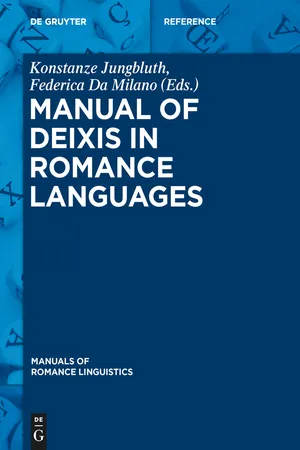![]()
Deixis in Romance Languages
![]()
Alexandra Corina Stavinschi
1 Romanian
Abstract: Romanian is one of the most understudied Romance Languages despite having a rich and often atypical deictic system which sets it apart from the rest. Research has mainly focused on morphological and phonological variation with little or no attention to pragmatic usage. Only recently, albeit sporadically, have scholars begun to obviate this shortcoming (Ionescu-Ruxăndoiu 1992; 1993; Hobjilă 2003; GALR 2005; GR 2013; RGR 2013). From these sources as from other data it is evident that there are no clear boundaries between the traditional categories of deixis. A close look at this overlap provides valuable insights into the grammaticalization process, and ultimately into how the human mind works. This chapter is based on a survey of the most relevant studies on the topic, but also includes new suggestions, in an attempt to draw attention on the peculiarities of the Romanian deixis and open new avenues for research.
Keywords: Romance Languages, Romanian, language varieties, pragmatics, grammar, deixis, spatial deixis, temporal deixis, personal deixis, social deixis, textual deixis, modal deixis, anaphora, demonstratives, demonstrative adverbs, demonstrative pronouns
0 Introduction
Deictics have a number of core features that are activated differently depending on the speech act participants and on the communicative setting. They establish references which vary according to the circumstances. Based on the classification provided by GALR 2005, 644, we shall consider the following categories:
1.Spatial deixis
2.Temporal deixis
3.Personal deixis (including social deixis)
4.Textual deixis and anaphora
5.Modal deixis.
1 Spatial deixis
Spatial deictic distinctions are grammatically encoded in the demonstrative system. Demonstratives (pronominal, adnominal and adverbial) are used to highlight proximity or distance (physical or psychological) from the deictic centre. Like all the other Romance Languages, Romanian has a demonstrative system based on the rearrangement of the tripartite Latin system HIC-ISTE-ILLE (↗22 From Latin and Vulgar Latin to Romance Languages). The proximal HIC is lost and so is the ternary articulation. Standard Romanian uses a binary distinction with fairly fuzzy boundaries. For pronominal/adnominal uses, there is a main contrast between proximal acesta (with the short form ăsta) vs distal acela (short form ăla); for adverbial uses, between aici vs acolo (see below). As far as the opposition acesta/acela is concerned, the marked form is thought to be acela; acesta is considered the unmarked term as it is used when distance is immaterial (RGR 2013, 189). In spite of the relatively simple underlying structure, a significant number of cognate forms are employed. The choice of one variant over the other is subject to a number of diaphasic, diatopic and diachronic variables.
Table 1: Demonstrative pronouns in Romanian.
Etymologically, the long forms of the series acesta/acela derive from Lat. ECCE+ISTE/ECCE+ILLE, while the short forms of the series ăsta/ăla derive from ISTE/ILLE. The latter do not occur in prenominal position. In spoken language, there is a strong tendency to employ the etymologically short forms ăsta/ăla (Nicula 2009), while the series acesta/acela has a more formal connotation, and is thus preferred in the written language. For their distributional and syntactic characteristics, see GALR (2005, 297–298). When determined by a prenominal demonstrative, nouns must be indefinite; conversely, they must always be definite when accompanying a postnominal demonstrative: acest om ‘this man’ vs omul acesta ‘the man this’.
According to the literature, at least in literary Romanian, prenominal demonstratives tend to be used with current discourse topics, whereas postnominal demonstratives are preferred for rhematic and contrastive uses. However, “in modern-day spoken Romanian, this interpretative difference between prenominal and postnominal demonstratives is lost, being superseded by a difference in register: the prenominal forms are literary and formal, the postnominal forms are generalized in the colloquial register” (RGR 2013, 162).
The syntactic position of the determiner – pre- or postnominal – may yield different interpretations: Ionescu ăsta vs acest Ionescu, with the former conveying a pejorative value and the latter ambiguous between a pejorative value and a mere anaphoric reading (cf. GR 2013, 299; see also RGR 2013, 161). However, the etymologically long forms seem to be ruled out by proper names when following a noun: Ionescu *acesta ‘Ionescu *this’ but omul acesta ‘the man this’. The interpretation could ultimately be driven by the informal i.e. familiar connotation of the etymologically not reinforced form ăsta ‘this’.
Prenominal demonstratives are mere endophoric determiners; they are used as a text-cohesion device (see section 4 below). By contrast, postnominal demonstratives are emphatic elements endowed with a specificity feature. This position communicates a focus (GR 2013, 299). As a consequence, contrastive stress is more common with postnominal demonstratives: cartea aceasta, nu aceea ‘book this, not that (one)’ as opposed to the less felicitous ?această carte, nu aceea ‘this book, not that (one)’. A possible explanation is that in oral speech, the postnominal forms ăsta/ăla largely prevail: in fact, this language use typically occurs in face-to-face interaction.
Regionally, the demonstrative system may have a ternary structure, with an intermediate term related to the interlocutor (see Data 1 below: aci ‘there, next to you’, 2nd term, expressing proximity to the hearer). This is thought to be the case of the dialect spoken in Oltenia (Hobjilă 2003, 136), with its tripartite distinction: aici (adverb)-ăsta (pronominal/adnominal) ‘close to speaker’, aci-ala ‘close to hearer’ and acolo-ăla ‘far from both’ (see Data 2 below: aici ‘next to me, proximal’, 1st term constrasts with aci ‘at a middle distance’, 2nd term). In Aromanian (Grămostean and Fărşerot) aoaţe contrasts with aţia (< Lat. HIC+ ECCE) and aclo (cf. Nevaci 2007, 72; Nevaci 2013, 261). However, the pronominal system has a binary structure, consisting of aistu ‘this’ and aţel ‘that’ (Nevaci 2007, 74). The proximal and distal demonstratives do not change their form when used as adjectives (for dialectal variation see Nevaci 2013, 236–261).
E! ce-ai cu săcurea? Las-o focului aci, une-o fi pus-o alde tat-tu. (Oltenia: Sterescu)
‘Hey! What are you doing with...

